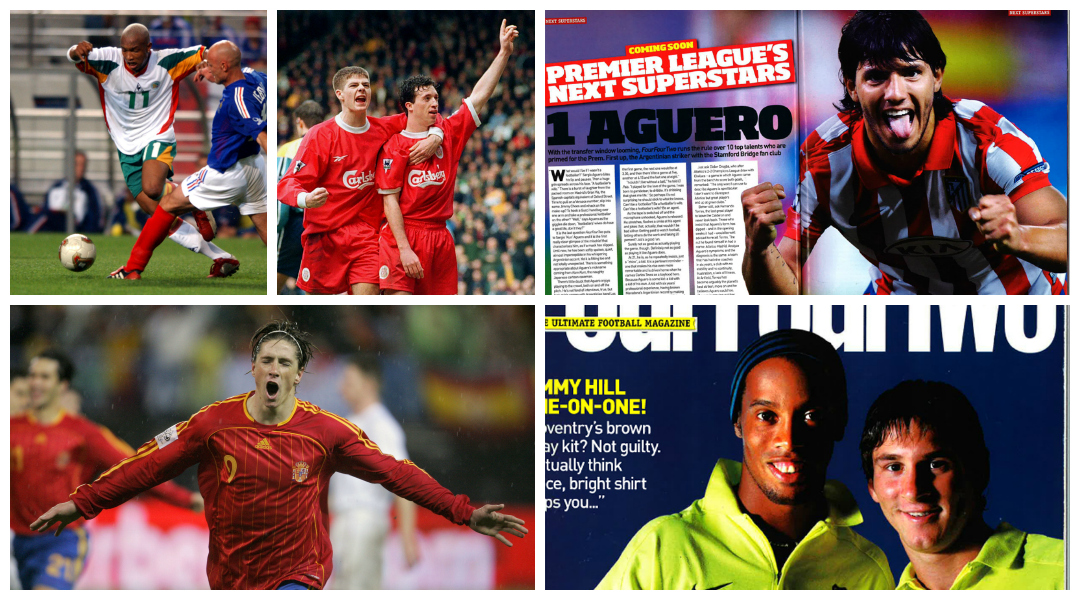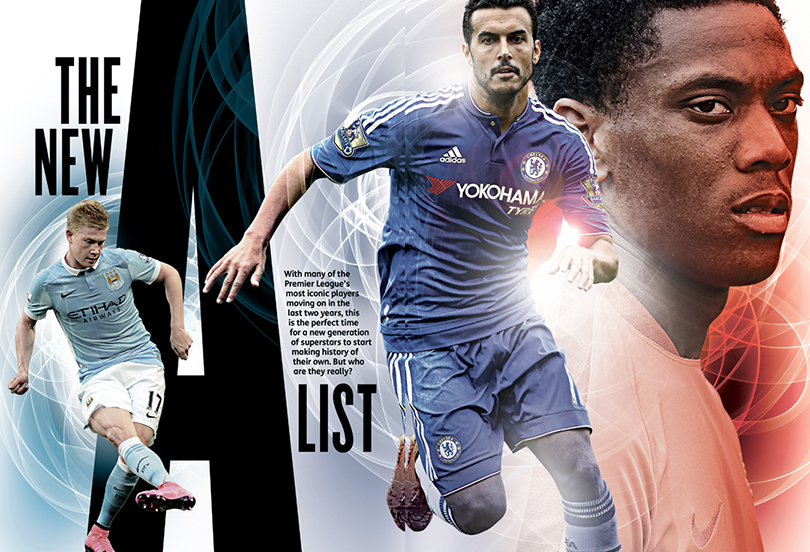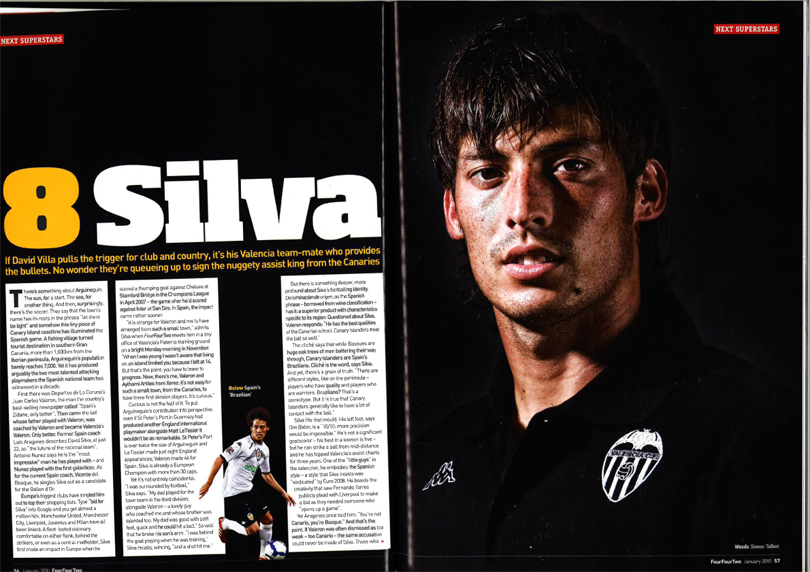The Premier League's New A-List: how did we do predicting the stars of tomorrow?
Louis Massarella recalls some of our best predictions. And a couple of not so hot ones...

In the latest issue of FFT, we confidently predict that Pedro, Kevin De Bruyne and Anthony Martial will soon establish themselves among the Premier League’s ‘New A-List’. But what's our form like when it comes to tipping young talent for the top? Pretty good, actually, as (most of) the following examples from five years ago or more prove. No pressure, lads...

THE GOOD
Steven Gerrard, ‘England’s new life’, May 2001

What we said: “The man to anchor England’s midfield for years to come.”
What happened next: Having just turned 21, Gerrard would, indeed, become a fixture in the Three Lions engine room for the next decade and beyond, but not before missing the 2002 World Cup through one of a series of niggling early-career injuries. And, arguably, he didn’t find consistent international form until, as captain, he finally settled for a deep-lying role, having spent years jostling with Frank Lampard for a more advanced position.
*Also in Issue 81, Wes Brown and Ashley Cole made up a triumvirate of young cover stars. While Cole latter became arguably England’s most consistent player of his generation, joining Gerrard among the centurions and being hailed as the best left-back in the world, Brown was never likely to live up to FFT’s ‘New Bobby Moore’ billing. Instead, the injury-hit Manc had to make do with a solid Premier League career and 23 caps.

Fernando Torres, ‘The Next Premiership Superstars’, June 2005
The best features, fun and footballing quizzes, straight to your inbox every week.
What we said: “The most talented Spaniard of a generation, a powerful, agile and supremely skilful striker, not unreasonably compared to Marco van Basten.”
What happened next: Torres joined Liverpool a year later, where he enjoyed three goal-laden – if trophyless – seasons. During this period, he also scored the winner for Spain at Euro 2008. But after the departure of Rafa Benitez, his form, and with it his confidence, dipped, and rarely returned after a big-money move to Chelsea in January 2011, despite winning an FA Cup, the Champions League and scoring a goal in the final as the Blues lifted the 2013 Europa League.
*Also in issue 130, FFT said it “looked like a straight fight between Manchester United and Arsenal” for Lyon’s 22-year-old powerhouse midfielder, Michael Essien. Right country, wrong club. Newly-crowned champions Chelsea made him an offer he couldn’t refuse just weeks later and the Ghanaian established himself as one of the finest midfielders in Europe, winning nine trophies at the Bridge, despite several serious knee injuries.
Lionel Messi, ‘Ronaldinho introduces…”, January 2006

What we said: “The likenesses in the way the pair [Maradona and Messi] play are staggering: the low centre of gravity, the lethal acceleration, the ability to dribble past players as though they are training ground dummies.”
What happened next: After telling FourFourTwo that Messi was the better player, Ronaldinho’s young team-mate mate – the Brazilian was the reigning Ballon D’Or holder, remember – went about proving it, despite missing the subsequent Champions League final through injury and playing just a bit part in that summer’s World Cup finals. He was first choice for club and country within a year, and firmly established as the world’s best player in under three. You heard it here first.
Neymar, ‘New World Superstars’, April 2009
What we said: Ok, so heading up FFT’s 10 to watch in our South America issue (176) were Hernanes and Ezequiel Lavezzi, who despite decent careers, have fallen just short of global greatness. So, you could argue, has Radamel Falcao, who headed for Europe for four seasons with Porto then Atletico, just after we modestly bigged him up as “versatile and hardworking”.
What happened next: Nestled next to the Colombian on page 47, though, was a skinny, skin-headed, 17-year-old Brazilian who had yet to play a first-team game for Santos. Six years later, Neymar has won the lot in South America and Europe, is approaching a half-century of goals for Brazil and has hair. Lots and lots of hair.
David Silva and Sergio Aguero, ‘Premier League’s Next Superstars’, January 2010

What we said: “Type ‘bid for Silva’ into Google and you get almost a million hits. Manchester United, Manchester City, Liverpool, Milan and Juventus have all been linked.” “Aguero is a phenomenal player… targetman and playmaker rolled into one.”

What happened next: While Silva joined City that summer, despite little game-time at the World Cup, it was Chelsea who were being most strongly linked with Aguero at the time. Instead, he gave Atletico one more year, by which time Carlo Ancelotti’s Blues’ departure and City’s first trophy (the FA Cup) for 35 years had helped make the Etihad a more attractive proposition. Both, often in tandem, have established themselves among the Premier League’s top five players, their brilliance in winning two titles ensuring hero status among the fans.

THE BAD
John Bostock, ‘The Wonder Kids’, January 2009
What he said: “I want to play for England, play in the Champions League, get to all the great tournaments, but above all I want to fulfill he talent I’ve got.”
What happened next: Having joined from Palace, where he’d made his debut aged 15, “one of English football’s hottest properties” never played a Premier League game for Spurs, going on loan six times before rebuilding his career in Belgian football, where he tore up the second flight last season. At 23, there’s still time.
*Also in issue 173, FFT clearly hadn’t been taking our tablets when we tipped such luminaries as Geoffrey Castillion and Rabiu Ibrahim to make it to the stop alongside Bostock. Of the other ten, however, all have enjoyed decent top-flight careers thus far, with Miralem Pjanic, Jack Wilshere and Mario Balotelli hitting the headlines for a variety of reasons.
THE UGLY
El Hadji Diouf, ‘Meet the Premiership’s Next Superstar’, November 2002

What we said: “Gerard Houllier’s next step into transforming Liverpool into Premiership champions... Diouf has what it takes to be a major hit at Anfield.”
What happened next: The Senegalese striker – a star at that year’s World Cup – did become one of the most well-known players in the Premier League, but usually for all the wrong reasons, most notably in a series of spitting incidents. He scored just six goals in two seasons for Liverpool, before a slightly more successful spell for Bolton. Sunderland, Blackburn, Rangers, Doncaster and Leeds followed, with controversy rarely far behind.
The November 2015 issue of FourFourTwo is available in print, on iPad and iPhone now and features 'The New A-List' as Anthony Martial, Kevin De Bruyne and Pedro attempt to take the Premier League by storm. We go One-on-One with Brazilian legend Cafu, chat to Crystal Palace boss Alan Pardew about the England job and experience a new city derby as Westfields host the newly formed Hereford FC. Plus, we ask Football League clubs whether youth academies are really worth it these days, remember when ClubCall was the best way to learn the latest news about your team and hear from England captain Steph Houghton. Subscribe!

